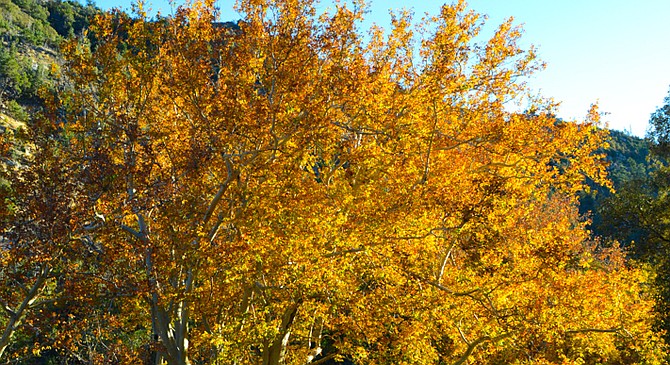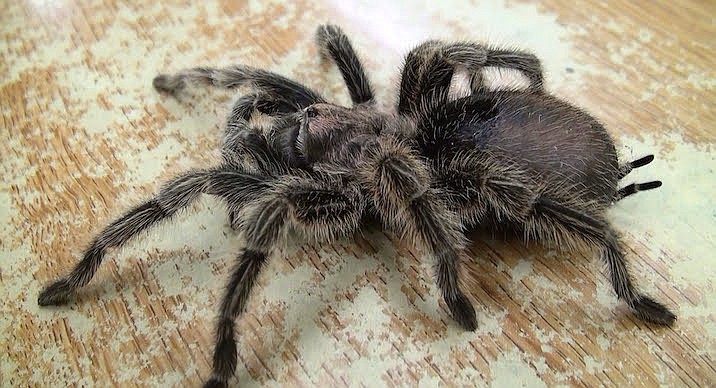 Facebook
Facebook
 X
X
 Instagram
Instagram
 TikTok
TikTok
 Youtube
Youtube

November’s and December’s Vividly Colorful Sunsets and sunrises are no accident. This is the time of year when high cirrus clouds, often the precursors of storms, sweep through our area with some regularity. When cirrus or other lofty clouds are present, low-angle sunlight bathes the undersides of these clouds in a crimson luminescence. This effect is most noticeable a half hour to a few minutes before the sun rises and a few minutes to a half hour after the sun sets.
Sycamores, found in San Diego’s coastal and foothill canyons as well as in suburban and park landscaping, stand at their autumnal best this time of year. Stroll beneath their crispy, rustling canopies and catch the sunbeams scattering among their mottled trunks and yellow-brown leaves. Some of San Diego’s biggest native sycamores reside in Lopez Canyon, a part of Los Peñasquitos Canyon Preserve near Sorrento Valley. Hundreds of sycamores can be also be seen in Marian Bear Park (San Clemente Canyon) along Freeway 52 between University City and Clairemont.

Roaming Tarantula Spiders are occasionally seen this time of year crossing rural roads or marching through some of San Diego’s canyon-bordering neighborhoods. Doggedly searching for a mate, a male will try to hold his course despite your best effort to deflect or hinder him. Docile in temperament, most tarantulas will tolerate gentle handling; they may bite, however, if provoked. Despite their fearsome reputation, tarantula venom is less powerful than a bee’s.
Full Moon. A weird, borderline-partial-total eclipse of the Moon awaits you in the early-morning hours of Friday the 19th. Mid-eclipse is at 1:03 a.m. The partial phase of the eclipse begins 1 hour 15 minutes before that time and ends 1 hour 15 minutes after.
The above comes from the Outdoors listings in the Reader compiled by Jerry Schad, author of Afoot & Afield in San Diego County. Schad died in 2011. Planet information from SkyandTelescope.org.


November’s and December’s Vividly Colorful Sunsets and sunrises are no accident. This is the time of year when high cirrus clouds, often the precursors of storms, sweep through our area with some regularity. When cirrus or other lofty clouds are present, low-angle sunlight bathes the undersides of these clouds in a crimson luminescence. This effect is most noticeable a half hour to a few minutes before the sun rises and a few minutes to a half hour after the sun sets.
Sycamores, found in San Diego’s coastal and foothill canyons as well as in suburban and park landscaping, stand at their autumnal best this time of year. Stroll beneath their crispy, rustling canopies and catch the sunbeams scattering among their mottled trunks and yellow-brown leaves. Some of San Diego’s biggest native sycamores reside in Lopez Canyon, a part of Los Peñasquitos Canyon Preserve near Sorrento Valley. Hundreds of sycamores can be also be seen in Marian Bear Park (San Clemente Canyon) along Freeway 52 between University City and Clairemont.

Roaming Tarantula Spiders are occasionally seen this time of year crossing rural roads or marching through some of San Diego’s canyon-bordering neighborhoods. Doggedly searching for a mate, a male will try to hold his course despite your best effort to deflect or hinder him. Docile in temperament, most tarantulas will tolerate gentle handling; they may bite, however, if provoked. Despite their fearsome reputation, tarantula venom is less powerful than a bee’s.
Full Moon. A weird, borderline-partial-total eclipse of the Moon awaits you in the early-morning hours of Friday the 19th. Mid-eclipse is at 1:03 a.m. The partial phase of the eclipse begins 1 hour 15 minutes before that time and ends 1 hour 15 minutes after.
The above comes from the Outdoors listings in the Reader compiled by Jerry Schad, author of Afoot & Afield in San Diego County. Schad died in 2011. Planet information from SkyandTelescope.org.
Comments